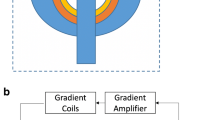Abstract
Cerebral perfusion-weighted imaging (PWI) in neonates is known to be technically difficult and there are very few published studies on its use in preterm infants. In this paper, we describe one convenient method to perform PWI in neonates, a method only recently used in newborns. A device was used to manually inject gadolinium contrast material intravenously in an easy, quick and reproducible way. We studied 28 newborn infants, with various gestational ages and weights, including both normal infants and those suffering from different brain pathologies. A signal intensity–time curve was obtained for each infant, allowing us to build perfusion maps. This technique offered a fast and easy method to manually inject a bolus gadolinium contrast material, which is essential in performing PWI in neonates. Cerebral PWI is technically feasible and reproducible in neonates of various gestational age and with various pathologies.



Similar content being viewed by others
References
Tanner SF, Cornette L, Ramenghi LA et al (2003) Cerebral perfusion in infants and neonates: preliminary results obtained using dynamic susceptibility contrast enhanced magnetic resonance imaging. Arch Dis Child Fetal Neonatal Ed 88:F525–F530
Rutherford M, Ward P, Allsop J et al (2005) Magnetic resonance imaging in neonatal encephalopathy. Early Hum Dev 81:13–25
Huisman TA, Sorensen AG (2004) Perfusion-weighted magnetic resonance imaging of the brain: techniques and application in children. Eur Radiol 14:59–72
Amaral JG, Traubici J, BenDavid G et al (2006) Safety of power injector use in children as measured by incidence of extravasation. AJR 187:580–583
Powell CC, Li JM, Rodino L et al (2000) A new device to limit extravasation during contrast-enhanced CT. AJR 174:315–318
Sistrom CL, Gay SB, Peffley L (1991) Extravasation of iopamidol and iohexol during contrast-enhanced CT: report of 28 cases. Radiology 180:707–710
Wintermark P, Moessinger AC, Gudinchet F et al (2008) Temporal evolution of MR perfusion in neonatal hypoxic-ischemic encephalopathy. J Magn Reson Imaging 27:1229–1234
Mendichovszky IA, Marks SD, Simcock CM et al (2008) Gadolinium and nephrogenic systemic fibrosis: time to tighten practice. Pediatr Radiol 38:489–496; quiz 602–603
Author information
Authors and Affiliations
Corresponding author
Rights and permissions
About this article
Cite this article
Laswad, T., Wintermark, P., Alamo, L. et al. Method for performing cerebral perfusion-weighted MRI in neonates. Pediatr Radiol 39, 260–264 (2009). https://doi.org/10.1007/s00247-008-1081-9
Received:
Revised:
Accepted:
Published:
Issue Date:
DOI: https://doi.org/10.1007/s00247-008-1081-9




